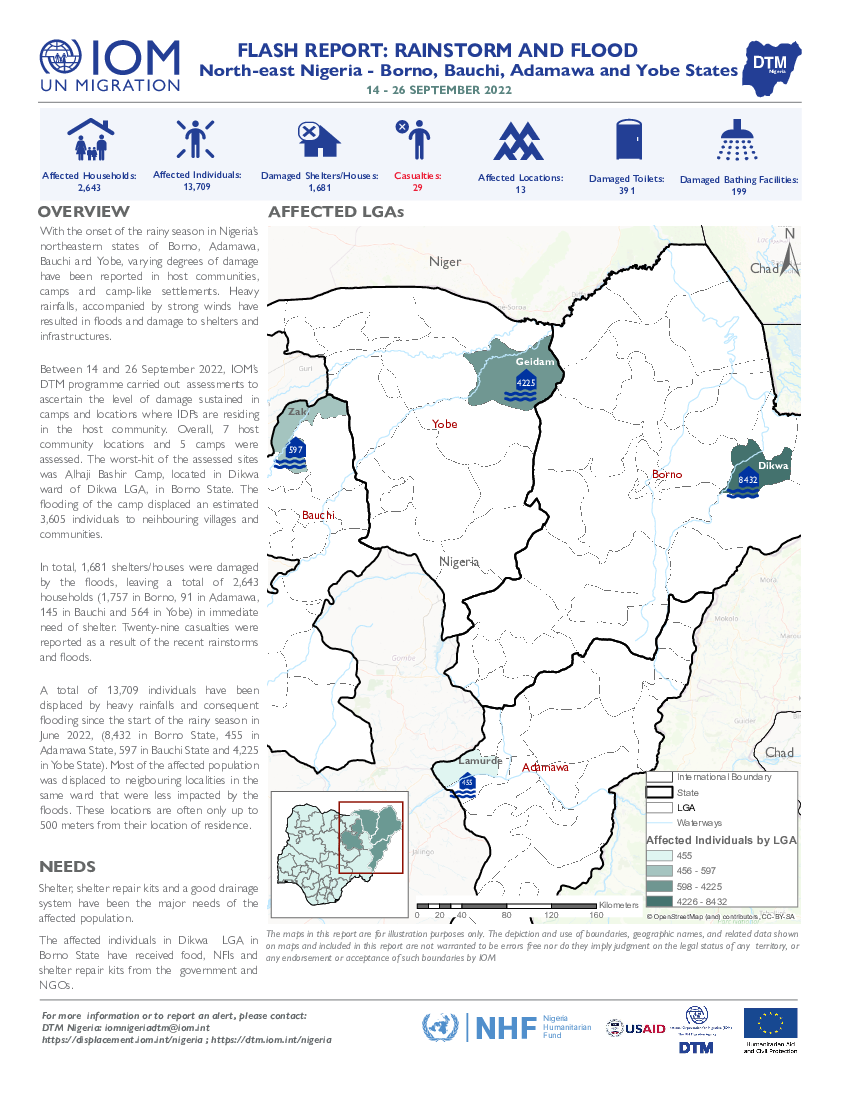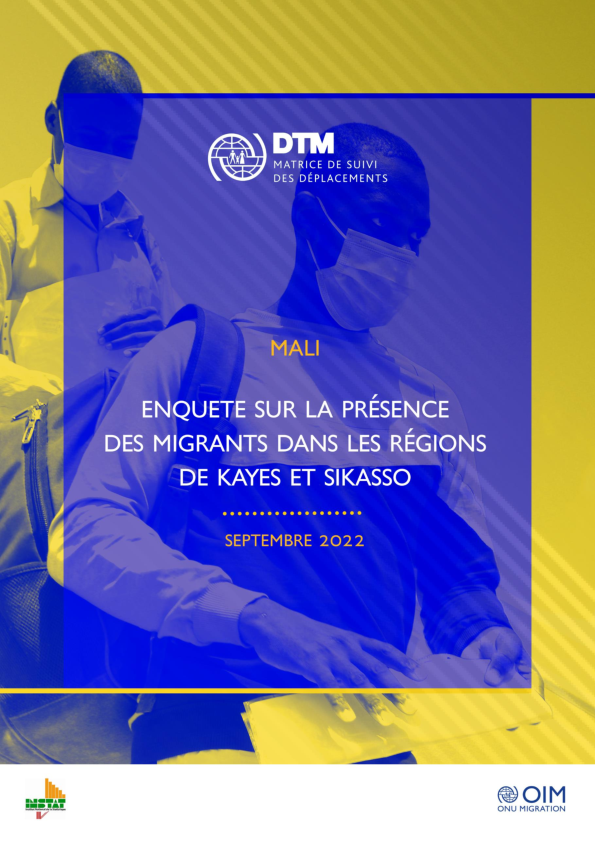-
Countries
-
Data and Analysis
-
Special Focus
-
Crisis Responses

Contact
DTM Nigeria, AllUsersInDTMNigeria@iom.int
Language
English
Location
Nigeria
Period Covered
Sep 01 2022
Sep 30 2022
Activity
- Event Tracking
A transhumance is a practice of pastoralism while sedentary farming activities are usually a method of agriculture in which the same land is farmed every year. Both practices represent two of the main ancestry and extensive economic activities within the West and Central Africa Sahel region. Traditionally, In Adamawa state, the farmers’ and herders’ livelihoods have complemented each other and the instance of conflicts was addressed by the established conflict resolution mechanisms and the traditional institutions. However, over the past few decades, a wide range of factors have resulted in tensions often ending in deadly violent conflicts between the two groups. Factors such as population increment, desertification, climate change, inadequate rainfall and shrinking grazing lands have worsened the already delicate situation. These factors arguably lead to competition over the inelastic scarce natural resources and often set the stage for violent conflicts that contribute to the cause of farmer-herder conflicts in Adamawa.
Key informants, through the community focal person, submit alerts relating to transhumance activities that support the Early Warning System of Transhumance Tracking Tool (TTT) as a component of the IOM's Displacement Tracking Matrix (DTM). This report presents TTT Early Warning alerts collected in five LGAs of Adamawa State (Demsa, Girei, Lamurde, Numan and Mayo-Belwa) for September 2022. During this period under review, 232 alerts were recorded, including 228 events and 4 movements representing 98 and 2 per cent, respectively. Girei LGA recorded the highest number of alerts at 25 per cent, followed by Demsa LGA at 24 per cent and Numan at 19 per cent while Lamurde and Mayo-Belwa LGAs are16 per cent each. Disaggregated data suggested that Ndikong and Gereng wards in Mayo-Belwa LGAs, respectively recorded high numbers at 7 per cent each of the total event alerts for the month. Events alerts include agro-pastoral conflict, intra-and inter-community tensions, Kidnappings, robberies, accidents, and attacks, disasters due to natural hazard, cattle rustling/livestock theft, etc.
Some conflict-prone potential risk areas from preventive alerts were identified for the month under review in Fufore LGA (Mayo-Inne ward), Girei LGAs (Wuro Dole ward), Mayo-Belwa LGA (Gengle, Mbilla and Ndikong wards) and Yola South LGA (Bole Yolde Pate ward).

Contact
DTM Nigeria, AllUsersInDTMNigeria@iom.int
Language
English
Location
Nigeria
Period Covered
Oct 03 2022
Oct 09 2022
Activity
- Mobility Tracking
- Event Tracking
The DTM Emergency Tracking Tool (ETT) is deployed to track and to collect information on large and sudden population movements, provide frequent updates on the scale of displacement and quantify the affected population when needed. As a sub-component of the Mobility Tracking methodology in Nigeria, ETT utilises direct observation and a broad network of key informants to capture best estimates of the affected population per location, enabling targeted humanitarian response planning.
Between 03 and 09 October 2022, a total of 1,640 new arrivals were recorded in locations in Adamawa, Borno and Yobe States. The new arrivals were recorded at locations in Askira/Uba, Bama, Biu, Dikwa, Gwoza, Hawul, Kala Balge, Monguno, and Ngala Local Government Areas (LGAs) of the most conflict-affected state of Borno and in Fufore, Girei, Gombi, Hong, Lamurde, Maiha, Michika, Mubi North, Numan, Yola North, Yola South, and Song LGAs of Adamawa and in Bade LGA of Yobe State.
On 04 and 06 October, armed herders reportedly attacked the communities Ityuluv in Ityuluv ward of Ukum LGA and Tsukwa in Tombo ward of Logo LGA. Both LGAs are located in Benue State. The attacks affected 1,030 individuals and led to the displacement of 1,010 individuals to Zaki Biam in Uyam ward of Ukum LGA and Government Secondary Technical School Anyiin Camp in Mbagber ward of Logo LGA. As a result of the attacks, 20 fatalities and 36 injuries were reported.
On 03 and 05 October, due to the opening of the Lagdo dam in Cameroon, the river Benue overflowed and caused floods in the communities Inniongun in Modern Market ward of Makurdi LGA and Usha in Usha ward of Agatu LGA in Benue state. The floods affected 762 individuals and displaced them to neighbouring communities. As a result of the floods, 3 injuries were reported.
On 09 October, armed herders reportedly attacked the communities Rest House/Gidan Sule, Ocha, Nyamadaga, Ipana, Agon, Agada and Kala in Kadarko ward of Keana LGA in Nasarawa state. The attacks affected 2,805 individuals and led to the displacement of 2,794 individuals to Giza Primary School Camp in Giza ward and neighbouring wards. As a result of the attacks, 11 fatalities and 7 injuries were reported.
On 06, 08 and 09 October, armed bandits reportedly attacked the communities Birnin Waje, Gwama village, Dabguruba and Tashi Taya village in Zurumai ward of Bukkuyum LGA, Tashar Turame village in Gayari ward of Gummi LGA of Zamfara state and Mamman Suka of Asara ward of Gwadamawa LGA of Sokoto state. The attacks affected 2,869 individuals and led to the displacement of 2,831 individuals to Bukkuyum town and Rafi in Zamfara state and Gwadabawa town in Sokoto state. As a result of the attacks, 38 fatalities and 61 injuries were reported.
With the onset of the rainy season in Nigeria’s northeastern states of Yobe and Bauchi, varying degrees of damages have been reported in locations in Warji, Karasuwa and Geidam LGAs. Heavy rainfall resulted in floods and caused serious damages to shelters and infrastructure.
Between 27 September and 11 October 2022, IOM’s DTM programme carried out assessments to ascertain the level of damage sustained in the affected locations. Overall, 6 locations in Warji, Karasuwa and Geidam LGAs were assessed. The worst-hit of the assessed sites was Kwata, a host community location in Kawuri ward of Geidam LGA, where flood damaged 89 shelters, affecting an estimated 1,014 individuals.
In total, 156 shelters were either damaged by rainfall or floods, leaving a total of 1,174 households in immediate need of shelter. No casualties were reported as a result of the floods.

Contact
DTM Nigeria, AllUsersInDTMNigeria@iom.int
Language
English
Location
Nigeria
Period Covered
Sep 14 2022
Sep 26 2022
Activity
- Mobility Tracking
- Event Tracking
With the onset of the rainy season in Nigeria’s northeastern states of Borno, Adamawa, Bauchi and Yobe, varying degrees of damage have been reported in host communities, camps and camp-like settlements. Heavy rainfalls, accompanied by strong winds have resulted in floods and damage to shelters and infrastructures.
Between 14 and 26 September 2022, IOM’s DTM programme carried out assessments to ascertain the level of damage sustained in camps and locations where IDPs are residing in the host community. Overall, 7 host community locations and 5 camps were assessed. The worst-hit of the assessed sites was Alhaji Bashir Camp, located in Dikwa ward of Dikwa LGA, in Borno State. The flooding of the camp displaced an estimated 3,605 individuals to neihbouring villages and communities.

Contact
DTM Yemen, iomyemendtm@iom.int
Language
English
Location
Yemen
Period Covered
Oct 09 2022
Oct 15 2022
Activity
- Mobility Tracking
IOM Yemen DTM’s Rapid Displacement Tracking (RDT) tool collects data on estimated numbers of households forced to flee on a daily basis from their locations of origin or displacement, allowing for regular reporting of new displacements in terms of estimated numbers, geography, and needs. It also tracks returnees who returned to their location of origin.
From 1 January to 15 October 2022, IOM Yemen DTM tracked 9,124 households (HH) (54,744 Individuals) who experienced displacement at least once.
Between 9 and 15 October 2022, IOM Yemen DTM tracked 55 households (330 individuals) displaced at least once. The majority of people moved into/within the following governorates and districts:
- Marib (42 HHs) – Marib City (23 HHs), Marib (19 HHs) districts. Most displacements in the governorate originated from Al Hodeidah and Sanaa.
- Ad Dali (9 HHs) – Ad Dali (5 HHs), Qatabah (3 HHs), Al Hasayn (1 HHs) districts. Most displacements in the governorate originated from Ad Dali and Al Hodeidah.
- Al Hodeidah (2 HHs) – Al Khukhah (2 HHs) district. All displacements in the governorate were internal.
The majority of people moved from the following governorates and districts:
- Al Hodeidah (14 HHs) – Al Marawiah (9 HHs), Jabal Ras (2 HHs), At Tuhayta (2 HHs) districts.
- Sanaa (8 HHs) – Bani Dabyan (8 HHs) district.
- Ad Dali (7 HHs) – Qatabah (6 HHs), Ad Dali (1 HH) districts.
Contact
DTM Yemen, iomyemendtm@iom.int
Location
Yemen
Activity
- Mobility Tracking
- Event Tracking
Period Covered
Oct 09 2022 -Oct 15 2022
From 1 January to 15 October 2022, IOM Yemen DTM tracked 9,124 households (HH) (54,744 Individuals) who experienced displacement at least once.
Between 9 and 15 October 2022, IOM Yemen DTM tracked 55 households (330 individuals) displaced at least once. The majority of people moved into/within the following governorates and districts:
- Marib (42 HHs) – Marib City (23 HHs), Marib (19 HHs) districts. Most displacements in the governorate originated from Al Hodeidah and Sanaa.
- Ad Dali (9 HHs) – Ad Dali (5 HHs), Qatabah (3 HHs), Al Hasayn (1 HHs) districts. Most displacements in the governorate originated from Ad Dali and Al Hodeidah.
- Al Hodeidah (2 HHs) – Al Khukhah (2 HHs) district. All displacements in the governorate were internal.
- Al Hodeidah (14 HHs) – Al Marawiah (9 HHs), Jabal Ras (2 HHs), At Tuhayta (2 HHs) districts.
- Sanaa (8 HHs) – Bani Dabyan (8 HHs) district.
- Ad Dali (7 HHs) – Qatabah (6 HHs), Ad Dali (1 HH) districts.
Population Groups
Survey Methodology
Unit of Analysis Or Observation
Type of Survey or Assessment
Keywords
Geographical Scope
Administrative boundaries with available data
The current dataset covers the following administrative boundaries

Contact
DTM Somalia, IOMSomaliaDTM@iom.int
Language
English
Location
Somalia
Period Covered
Oct 01 2022
Oct 05 2022
Activity
- Mobility Tracking
- Event Tracking
Since November 2021, 302,023 individuals have been displaced by drought in Gedo region. Since round 30, an estimated 6,076 IDPs arrived at the assessed settlements.

Contact
DTM Mali, DTMMali@iom.int
Language
French
Location
Mali
Period Covered
Jul 25 2022
Aug 12 2022
Activity
- Survey
- Migrants presence
L’OIM, en collaboration avec l’Institut National de la Statistique du Mali (INSTAT), a mis en œuvre une enquête dite de Présence des Migrants entre juillet et août 2022. Cette enquête a pour objectif de mettre en lumière les tendances, profils, vulnérabilités et besoins spécifiques des populations migrantes afin de mettre en place un cadre spécifique en faveur de la protection des migrants, de la lutte contre la traite et de la promotion d’un retour sûr et digne en vue d’une réintégration durable.
Cette enquête s’est déroulée dans les régions de Kayes et Sikasso où, selon l’Enquête Modulaire Permanente Auprès des Ménages (EMOP) de l’INSTAT réalisée chaque année, une population migrante importante vie dans ces régions.
Sur la base de la population totale des migrants économiques des deux régions retenues, un échantillon de 1 350 de ces migrants a été sélectionné. La taille de cet échantillon a été répartie proportionnellement à la taille de la population migrante de chacune des communes des régions retenues.


